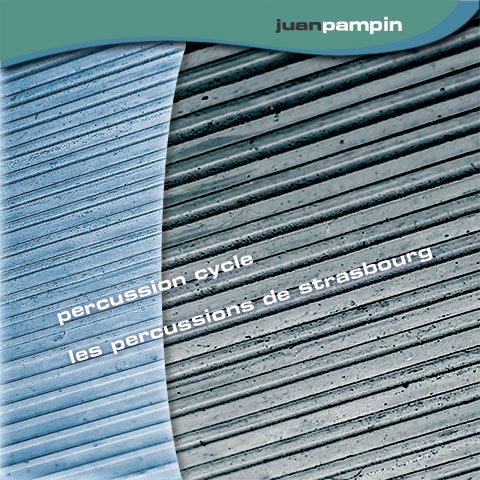Argentinean composer Juan Pampin’s ‘Percussion Cycle’ for percussion instruments and electronic sounds, performed by the renowned Les Percussions de Strasbourg, is comprised of four pieces: ‘Métal Hurlant’, ‘Toco Madera’, ‘Skin Heads’ and ‘On Space’. Each piece relates to the base material of the instruments used and is the result of an exploration of the timbral qualities of the material elements responsible for the production of sound: metals, wood, and skins. The last piece deals with the spatial relationship between all the percussion instruments and their electronic counterparts. Per- formed live, the pieces are executed by the musicians and speakers for the the electronics surrounding the audience.
Born in 1967, Pampin studied with Denis Lorrain and Philippe Manoury at the Conservatoire National Supérieur de Musique de Lyon, then at Stanford University’s Center for Computer Research in Music and Acoustics (CCRMA) where Juan began his work on ‘Percussion Cycle’, with his musical studies supervised by the British composer Jonathan Harvey. During this period Harvey acted as both a mentor and collaborator. Notably, Juan prepared the computer part of Harvey’s ‘Mothers Shall Not Cry’, a work commissioned by the BBC as part of the 2000 Royal Albert Hall Proms. Julius Smith, an expert in musical signal processing, was another influential figure from this time at CCRMA. Juan’s ‘Analysis, Transformation, Synthesis’ (ATS) software, an important contribution to research in spectral modeling, was developed with Smith’s encouragement and guidance. Much of what we hear in ‘Percussion Cycle’ can be described as ‘ATS in ac- tion’. An invitation from Richard Karpen brought a move from Stanford to Seattle in 1999. This initial appointment as a Research Associate at the University of Washington (UW) came with Juan’s growing reputation as both a talented com- poser and innovative researcher in musical signal processing. Juan became part of a group that went on to plan the de- velopment of a new research centre, bringing together arts and technology at UW, the Center for Digital Arts and Ex- perimental Media (DXARTS) which he has been directing since 2011.
Created in 1959, Les Percussions de Strasbourg very quickly inspired the creation of new works by composers such as Messiaen, Stockhausen, Serocki, Kabelac, Ohana, Xenakis, Mâche and Dufourt. A new repertoire for percussion took shape. As Pierre Boulez later said: “A repertoire was necessary for the Groupe, but the Groupe has made the rep- ertoire necessary.” Les Percussions de Strasbourg has, and continues to, actively commission and innovate, travelling all around the world to perform at major international festivals, performing more than 1600 concerts in 70 countries with a repertoire of more than 300 original works written for them. It has developed one of the most unique ‘instrumentarium’ in the world (+500 instruments), has published over 30 recordings, and been awarded more than 30 international prizes.
TRACK LIST:
1. Métal Hurlant (1996)- 13:32
2. Toco Madera (1997)- 15:22
3. Skin Heads (1998)- 14:28
4. On Space (2000 – 2005) – 20:33
Credits:
les percussions de strasbourg: Bernard Lesage, Claude Ferrier, Olaf Tzschoppe, Jean-Paul Bernard, Keiko Nakamura, François Papirer
recorded: on location by Joseph Anderson at Palais des Fêtes, Strasbourg, France, 9-13 January, 2006. Recording sessions supervised by the composer. Stereo Ambisonic UHJ Encoded
produced and mastered by: Joseph Anderson & Juan Pampin
Also available as downloads:



